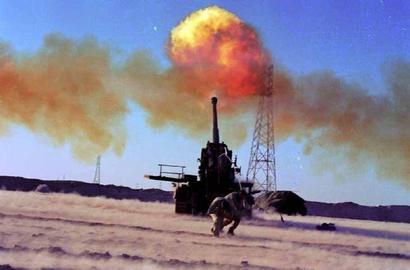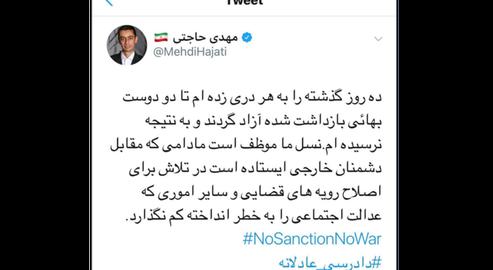On September 22, 1980, Iraq launched a massive military attack on Iran, while the Islamic Revolutionary Guard Corps (IRGC), was in the middle of a power struggle with the then Iranian president Abolhassan Banisadr and his allies.
At the beginning of the war, the Iranian regular army, the Artesh, which was formed before the Islamic revolution, was almost disintegrated, to the extent that most of its commanders had been purged, and even a number of them had been executed. At the same time, the IRGC was a newly-established army whose members were not adequately trained and armed.
Under such conditions, Iraqi forces could rapidly advance on to Iranian soil. The fact that Iranian military personnel was totally unprepared for war, as well as the lack of coordination between the IRGC and the Artesh, led to the occupation of about 15,000 square kilometers of Iran’s territory at the beginning of the war.
Iran’s Victories
After the removal of President Banisadr on June 21, 1981, the coordination between the IRGC and the Artesh increased, thus putting the Iranian forces in the offensive position. From late September 1981 to late May 1982, the IRGC and the Artesh, in four successful operations — Samen ol-Aemmeh, Tarigh ol-Quds, Fatah ol-Mobin and Beit ol-Moqaddas — retook most of Iran’s occupied territory. At this stage, the level of coordination between the IRGC and the Artesh was higher than at any other time in the course of the war.
Operation Beit ol-Moqaddas, during which the city of Khorramshahr in southwestern Iran was liberated, was the country’s biggest victory during the war. The victory in Khorramshahr put the Iranians in a dominant position from both military and political perspectives.
A few weeks after this victory, the Iraqi army, which was in a weak state, voluntarily retreated from large parts of Iran’s occupied territory. However, the Iraqis continued to occupy 1,400 square kilometers of Iranian soil.
On the other hand, after the liberation of Khorramshahr, Iranian authorities engaged in high-level internal discussions on whether to continue the war or not. In particular, the then Leader of the Islamic Republic, Ayatollah Khomeini, was uncertain about the costs and benefits of entering Iraqi territory. But other senior political and military officials managed to convince the Leader that Iranian troops had to enter Iraq in order to totally defeat Saddam Hussein, or even remove him from power. Over the course of this decision-making, the Revolutionary Guards played a decisive role.
After retaking Khorramshahr, the IRGC was so confident in its ability that it sent troops to Syria in order to help the Lebanese Shias, whose country had just been attacked by the Israeli army. Akbar Hashemi Rafsanjani, the then head of Iran’s parliament, wrote in his diaries that he was aware that Iranian troops had been deployed to help the Lebanese from the beginning, but he didn’t know that the IRGC pursued such ambitious goals as "conquering Palestine," too. The hasty deployment of Iranian troops to Syria was apparently done even before Ayatollah Khomeini’s approval; when the Leader became aware of this deployment, he stressed that Iran should absolutely not engage in a new war as long as Saddam Hussein remained undefeated.
Following Khomeini's remarks, the Iranian military returned to the country, but an elite group of the IRGC troops remained in Lebanon. By training and organizing the young Lebanese Shias, these IRGC troops formed the core of a militia force that was later known as the Lebanese Hezbollah.
Unsuccessful Attempts to Seize Basra
Less than two months after the conquest of Khorramshahr, based on the IRGC commanders’ plan, and despite the Artesh’s doubts about the feasibility of that plan, the Ramadan operation was launched to conquer Basra. This operation, which turned out to be the biggest tank battle since World War 2, failed dramatically.
After the Ramadan operation, in February 1983 and April 1983, Iranian forces carried out the preliminary Valfajr and Valfajr 1 operations into Iraqi territory. Iranian officials assumed that these two operations would end in Iranian victory. Again the IRGC and the Artesh had fundamental disagreements over the two operations, both of which failed.
In an attempt to bridge the growing gap between the IRGC and the Artesh, in December 1983 Ayatollah Khomeini appointed Hashemi Rafsanjani as the military commander of all IRGC and Artesh operations (at the end of the war, in June 1998, Khomeini promoted Rafsanjani to the position of acting Commander-in-Chief of the armed forces).
In February 1984 and March 1985, the IRGC convinced Rafsanjani that Khyber and Badr operations had to be carried out to cut off Basra from the rest of Iraq. These two operations, both led by the IRGC and backed by the Artesh, did not meet this particular goal. However, in the course of Khyber, Iranian troops were able to occupy Majnoon Islands in southeastern Iraq.
After the Khyber operation, the IRGC commanders draw up a plan to seize the al-Faw Peninsula and the Umm Qasr Port southeast of Basra in order to cut Iraq off from the Persian Gulf. Hashemi Rafsanjani told the IRGC commanders that if this operation succeeded, he would be able to end the war with Iraq from an upper-hand position.
The new operation, called Valfajr 8, was eventually launched in February 1986. In the course of this sophisticated operation, the Iranian forces successfully occupied the al-Faw strategic peninsula, but could not reach the Umm Qasr Port.
After the Valfajr 8 operation, in a meeting with IRGC commanders, Rafsanjani announced that the recent victory, despite its importance, was still inadequate to end the war, and concluded that another massive operation should be carried out.
The new IRGC operation was Karbala 4, which was launched in December 1986 in order to seize Basra, but the operation led to Iran’s most dramatic military defeat of the war. Only 16 days later, Iran carried out the Karbala 5 operation in the same region. During the operation, which took the Iraqis by surprise, the IRGC forces were not able to seize Basra, but managed to occupy parts of Iraq’s territory between Basra and Iran’s borders.
Resolution 598
During Karbala 5, Iran and Iraq suffered the heaviest casualties in the history of the eight-year war. After the operation, international efforts intensified to end the war, while it was clear that neither Iran nor Iraq could force the other to surrender. These attempts finally resulted in the formulation of Security Council Resolution 598. The resolution was issued on July 20, 1987.
Within two days, Iraq accepted the resolution. But Ayatollah Khomeini, due to IRGC reports about the situation of the battlefields, was still confident that the Islamic Republic would be able to win the war over Iraq. As a result, eight days after the resolution was issued, Khomeini announced that Iran had reached the limit of "absolute victory," and that the war would continue until "Saddam's downfall." Consequently, the Iranian government did not accept Resolution 598.
At the same time, Iraq's attacks on Iranian oil tankers were in a steep rise in the Persian Gulf. Following the retaliatory attacks from the IRGC, some of Saddam Hussein’s regional allies such as Kuwait agreed to transfer Iraq’s oil with their own tankers. Then, when these tankers were also targeted by IRGC speed boats, the USSR and the USA agreed to protect them by reflagging Kuwait-owned tankers as American and Soviet vessels. However, the IRGC continued to attack these reflagged vessels with speed boats and naval mines, leading to a number of severe military confrontations with the United States Navy.
With the intensification of the US Navy presence in the Persian Gulf, an American surface-to-air guided missile destroyed an Iranian Airbus in July 1988, killing all 290 passengers. The attackers later said they had confused the Airbus A300 with an Iranian F-14 fighter.
This is part one of a two-part series. The second part will be published in early June.
Read more in this series:
Decoding Iran’s Politics: The Formation of the Quds Force
visit the accountability section
In this section of Iran Wire, you can contact the officials and launch your campaign for various problems


























comments